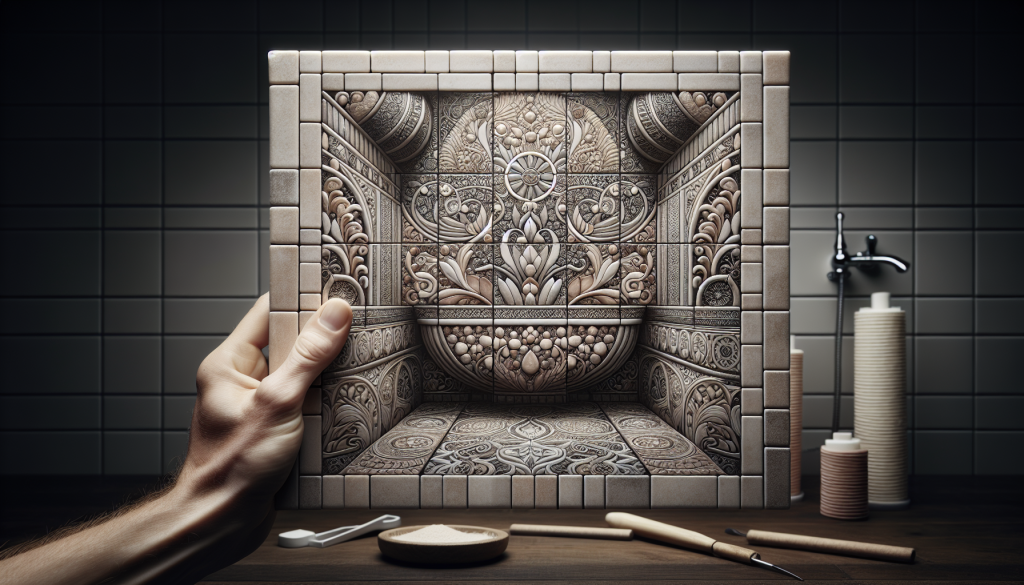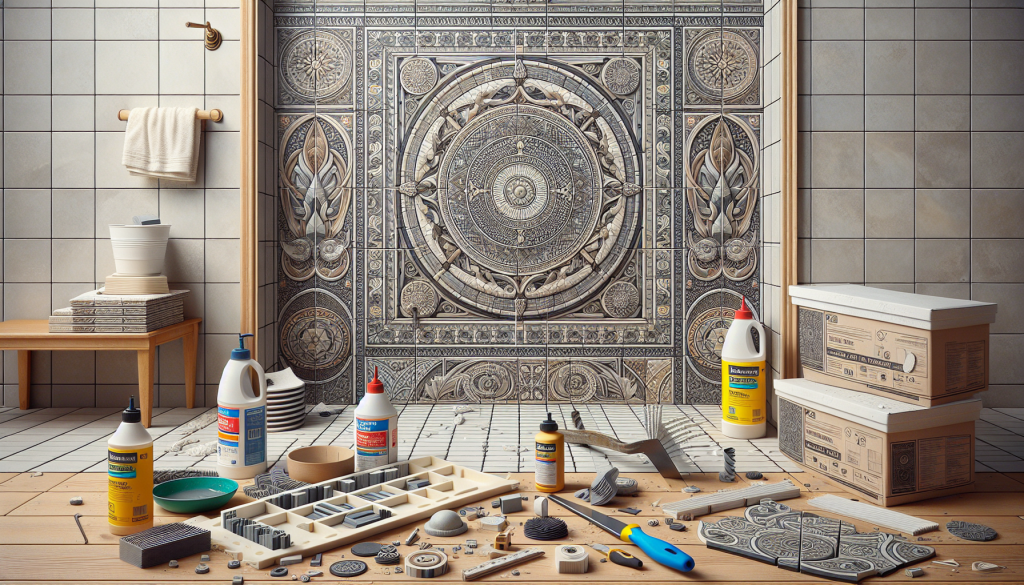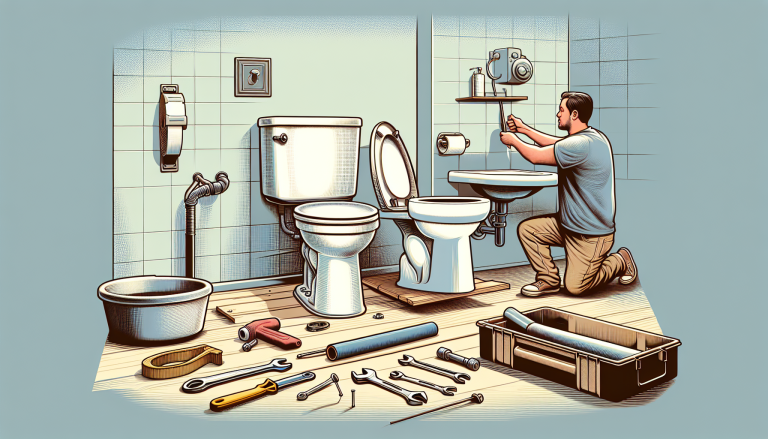Thinking of installing bathroom tiles on your own? Before you get started, it’s essential to consider a few key factors that will ensure a successful DIY project. From choosing the right type of tiles to preparing the surface and selecting the appropriate tools, this article will guide you through the crucial considerations for a seamless bathroom tile installation. Whether you’re a seasoned DIY enthusiast or a beginner, these tips and insights will help you achieve a professional-looking finish and transform your bathroom into a stylish oasis.
Table of Contents
ToggleChoosing the right type of tile
When it comes to choosing the right type of tile for your bathroom, there are several options to consider. Each type of tile has its own unique characteristics and benefits. Let’s take a closer look at some of the most popular options:
Porcelain tile
Porcelain tile is known for its durability and water resistance, making it an excellent choice for bathroom installations. It is made from a dense clay mixture that is fired at high temperatures, resulting in a hard, durable tile. Porcelain tile is available in a wide range of colors, patterns, and finishes, allowing you to create a customized look for your bathroom.
Ceramic tile
Ceramic tile is another popular choice for bathroom installations. It is made from clay and other minerals, which are then glazed and fired in a kiln. Ceramic tiles are available in a variety of sizes, shapes, colors, and patterns, making them versatile and suitable for any bathroom style. They are also relatively affordable and easy to install, making them a great option for DIY projects.
Stone tile
If you’re looking to add a touch of luxury and elegance to your bathroom, stone tile is an excellent choice. Types of stone tile commonly used in bathrooms include marble, granite, travertine, and limestone. Stone tiles are naturally beautiful and can add a unique and sophisticated look to your space. However, they do require regular maintenance and sealing to protect them from moisture damage.
Glass tile
Glass tile is a popular choice for adding a touch of color and shine to bathroom walls or accents. It can be used to create stunning mosaic patterns or as a simple border or backsplash. Glass tile comes in a wide array of colors, finishes, and sizes, making it a versatile choice for any bathroom design. It is also easy to clean and maintain, making it a practical choice for busy bathrooms.
Mosaic tile
Mosaic tile is made up of small pieces of tile arranged in a pattern or design. It can be made from a variety of materials, including ceramic, porcelain, glass, or stone. Mosaic tile is versatile and can be used to create intricate patterns or as a focal point in your bathroom design. It is also a great option for adding texture and visual interest to your space.
Determining the tile layout
Once you’ve chosen the type of tile you want for your bathroom, it’s time to start planning the layout. The tile layout will determine how your bathroom looks and functions, so it’s important to carefully consider a few key factors.
Consider the size and shape of the tiles
The size and shape of the tiles you choose will have a significant impact on the overall look of your bathroom. Larger tiles can make a small bathroom appear more spacious, while smaller tiles can create a visually interesting pattern or design. It’s also important to consider how the tile size and shape will work with the other elements in your bathroom, such as fixtures and cabinetry.
Decide on the pattern and design
The pattern and design of your tile layout can greatly enhance the overall aesthetic of your bathroom. Popular tile patterns include straight lay, diagonal, herringbone, and basketweave. You can also create unique designs using mosaic tiles or by combining different types of tiles. Take the time to sketch out different layout options and consider how they will complement the style and atmosphere you want to create in your bathroom.
Account for the grout lines
Grout lines are an important aspect of any tile installation, both functionally and aesthetically. The size and color of the grout lines can greatly impact the overall look of the tiled area. Thinner grout lines create a more seamless and contemporary look, while thicker grout lines can add a traditional and rustic feel. Consider the size of the tiles and the desired look of your bathroom when determining the width and color of the grout lines.
Preparing the surface
Properly preparing the surface before tile installation is crucial to ensure a successful and long-lasting installation. Here are some key steps to follow when preparing your bathroom surface:
Ensure the subfloor is structurally sound
Before installing tiles, it’s important to ensure that the subfloor is structurally sound and able to support the weight of the tiles. Check for any signs of damage, such as rot or decay, and make any necessary repairs. The subfloor should be level and free of any bumps or depressions to prevent future tile cracking or shifting.
Check for any existing damage or moisture
Inspect the walls and floor for any existing damage, such as cracks, water stains, or peeling paint. It’s crucial to address any underlying issues before installing tiles to prevent further damage and maintain the integrity of the tile installation. Additionally, make sure the bathroom is properly waterproofed and free of moisture to avoid future mold or mildew growth.
Remove any previous flooring or adhesive
If you’re replacing existing flooring in your bathroom, you’ll need to remove it before installing the new tiles. Use the appropriate tools, such as a pry bar or scraper, to carefully remove the old flooring. Be cautious not to damage the subfloor during this process. If there is any adhesive residue or uneven patches, it’s important to remove or repair them before proceeding with the tile installation.
Clean and smooth the surface
Once the previous flooring has been removed, thoroughly clean the surface to remove any dust, dirt, or debris. Use a mild detergent and warm water, along with a scrub brush or sponge, to clean the area. After cleaning, make sure the surface is completely dry before proceeding. If there are any uneven spots or rough patches, use a floor leveling compound or sandpaper to smooth them out.
Gathering the necessary tools and materials
Before you begin tiling, it’s important to gather all the necessary tools and materials to ensure a smooth and efficient installation. Here’s a list of the essential items you’ll need for the job:
Tiles
Select the type, size, and color of tiles that you want to use in your bathroom. Make sure to purchase enough tiles to cover the entire area, including extra tiles for future replacements or repairs.
Tile adhesive
Choose a high-quality tile adhesive that is suitable for your chosen tiles and substrate. Read and follow the manufacturer’s instructions for proper mixing and application.
Grout
Select a grout color that complements your tiles and desired aesthetic. It’s important to choose a grout that is suitable for your tile type and installation location. Follow the manufacturer’s instructions for mixing and application.
Tile spacers
Tile spacers are plastic or rubber devices used to ensure consistent grout lines between tiles. Choose the appropriate size of spacers based on the desired grout line width.
Trowel
A trowel is used to apply the tile adhesive onto the subfloor. The size of the trowel depends on the size and type of tiles being installed. It’s important to select a trowel with notches that are appropriate for your specific tile and adhesive.
Tile cutter
A tile cutter is used to make precise cuts on tiles that need to fit around obstacles, such as pipes or corners. There are various types of tile cutters available, including manual cutters, electric wet saws, or tile nibblers. Choose the method that best suits your needs and skill level.
Sponge
A sponge is used to clean excess grout off the tiles and smooth the grout lines. Make sure to choose a sponge that is suitable for grout application and cleanup.
Bucket
A bucket is essential for mixing the adhesive and grout. Choose a bucket that is large enough to accommodate the amount of adhesive or grout you’ll need for your project.
Grout float
A grout float is used to apply the grout into the gaps between the tiles. It helps to ensure an even and smooth application of grout. Choose a grout float with a comfortable handle and a soft rubber or foam bottom.
Level
A level is used to ensure that the tiles are installed correctly and evenly. Make sure to choose a level that is long enough to span across several tiles at once for accurate measurements.
Planning and marking the layout
Before you start installing the tiles, it’s essential to carefully plan and mark the layout to ensure a precise and visually pleasing installation. Here are the steps to follow:
Measure the dimensions of the bathroom
Using a tape measure, carefully measure the length and width of the bathroom. Take note of any obstructions or irregularities, such as corners or alcoves. This measurement will help you determine the number of tiles needed and assist in planning the layout.
Create a grid or sketch of the layout
Using graph paper or a computer program, create a grid or sketch of the bathroom layout. This will allow you to visualize the placement of the tiles and explore different design options. Use a scale that accurately represents the dimensions of the space for a more accurate representation.
Mark the starting point and reference lines
Choose a starting point for your tile installation, typically in a visible and central area of the bathroom. From the starting point, use a chalk line or straightedge to mark reference lines that will guide your tile placement. Ensure these reference lines are level and square with the walls for a professional-looking installation.
Applying the tile adhesive
Now that you have planned and marked the layout, it’s time to apply the tile adhesive. Here are the steps to follow:
Mix the adhesive according to the manufacturer’s instructions
Carefully read and follow the manufacturer’s instructions on the packaging of the tile adhesive. Use a bucket and a mixing paddle to combine the adhesive powder or pre-mixed adhesive with water. Stir the mixture until it reaches a smooth and creamy consistency, without any lumps.
Apply an even layer of adhesive on the subfloor
Using a trowel, spread a layer of adhesive onto the subfloor in a small section at a time. Hold the trowel at a 45-degree angle and use the notches on the trowel to create ridges in the adhesive. This will ensure proper adhesion and help prevent the tiles from slipping or shifting.
Use the appropriate trowel size for the tile
Select a trowel size that is appropriate for the size and type of tile you are installing. Larger tiles may require a larger trowel with deeper notches, while smaller tiles may require a smaller trowel with shallower notches. Apply the adhesive consistently and avoid applying too much or too little, as it can affect the tile’s adherence.
Installing the tiles
With the adhesive applied, it’s time to start installing the tiles. Here’s how to do it:
Place the tiles onto the adhesive
Carefully place the tiles onto the adhesive, starting at the marked reference lines and following the planned layout. Press each tile firmly into the adhesive, using a slight twisting motion to ensure proper adhesion. Use a slight amount of pressure to level the tiles and ensure they are installed evenly.
Ensure proper alignment and spacing
As you install each tile, make sure to check for proper alignment and spacing. Use a level or straightedge to ensure that the tiles are level and flush with each other. Adjust the positioning of the tiles as necessary to maintain consistent grout lines and a visually pleasing layout.
Use tile spacers for consistent grout lines
Insert tile spacers between each tile to maintain consistent grout lines. The size of the spacers will depend on the desired width of the grout lines. Place the spacers at the corners and edges of each tile, and remove them before grouting.
Trim or cut tiles as necessary
If you encounter areas that require tiles to be trimmed or cut, use a tile cutter or appropriate cutting tool. Measure and mark the tile where the cut needs to be made, and carefully follow the instructions for the cutting tool you are using. Make sure to wear appropriate safety equipment and take your time to achieve smooth and precise cuts.
Grouting the tiles
Once the tiles are installed and the adhesive has had sufficient time to dry, it’s time to grout the gaps between the tiles. Follow these steps to achieve a clean and professional-looking grout finish:
Mix the grout according to the manufacturer’s instructions
Read and follow the manufacturer’s instructions for mixing the grout. Combine the grout powder with water in a bucket, and stir until you achieve a smooth and creamy consistency. Avoid adding too much water, as it can weaken the grout.
Apply the grout into the gaps with a grout float
Using a grout float, apply the grout onto the surface of the tiles, pressing it firmly into the gaps. Hold the grout float at a 45-degree angle and use a sweeping motion to ensure the grout completely fills the gaps. Work in small sections at a time to prevent the grout from drying before you have a chance to clean it.
Remove excess grout with a sponge
After applying the grout, use a damp sponge to remove the excess grout from the tile surfaces. Hold the sponge at a 45-degree angle and lightly swipe across the tiles, being careful not to remove too much grout from the gaps. Rinse the sponge frequently and continue wiping until the tiles are clean and the grout lines are defined.
Clean and seal the grout lines
After the grout has dried for the recommended time indicated by the manufacturer, use a grout sealer to protect the grout lines. Apply the sealer according to the manufacturer’s instructions, using a brush or applicator. Allow the sealer to dry completely before using the bathroom or exposing the tiles to excessive moisture.
Allowing the tiles to set and dry
After the grout has been applied and sealed, it’s crucial to allow the tiles to set and dry properly. Follow these guidelines to ensure a durable and long-lasting tile installation:
Follow the recommended drying time by the adhesive and grout manufacturers
Different adhesives and grouts have varying drying times, so it’s important to follow the manufacturer’s recommendations. Avoid walking on the tiles or putting any heavy objects on them until they are fully dry. Failure to allow sufficient drying time can result in tile shifting or grout cracking.
Avoid walking on the tiles during the curing process
Even after the tiles have dried, it’s important to avoid excessive foot traffic on them during the curing process. This will help prevent any damage or shifting that could occur before the adhesive and grout are fully set.
Protect the tiles from excessive moisture
While the adhesive and grout are drying and curing, it’s crucial to protect the tiles from excessive moisture. Keep the bathroom well-ventilated to aid in the drying process and avoid exposing the tiles to water or steam until the installation is fully dry and cured.
Completing the finishing touches
Once the tiles have fully set and dried, it’s time to complete the finishing touches to achieve a polished and professional look. Here’s what you need to do:
Apply caulk around the edges and corners
Use a caulk gun and silicone caulk to seal the gaps between the tiles and the walls, as well as any corners or edges where moisture can seep through. Apply a thin and even bead of caulk, smooth it with a wet finger or caulk tool, and wipe away any excess caulk.
Install any necessary trim or molding
If your bathroom design calls for trim or molding, install it to create a clean and finished look. Choose trim or molding that complements the style and color of your tiles. Follow the manufacturer’s instructions for proper installation.
Clean the tiles and remove any grout haze
Once the installation is complete, thoroughly clean the tiles to remove any grout haze or residue. Use a mild tile cleaner and a sponge or soft cloth to gently clean the tiles, being careful not to scratch or damage the grout lines. Rinse the tiles with clean water and dry them thoroughly to reveal their natural shine.
Apply a grout sealer to protect the grout
To ensure the longevity of your grout and prevent staining or discoloration, apply a grout sealer according to the manufacturer’s instructions. This will help protect the grout from moisture, dirt, and stains, making it easier to clean and maintain in the future.
In conclusion, installing tiles in your bathroom can be a rewarding and cost-effective way to enhance the overall look and functionality of the space. By carefully choosing the right type of tile, planning and marking the layout, properly preparing the surface, and following the necessary steps for installation, you can achieve a professional-looking tile installation that will stand the test of time. Remember to take your time, follow the manufacturer’s instructions, and pay attention to the details to ensure a successful and beautiful DIY bathroom tile installation.








